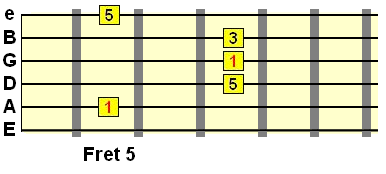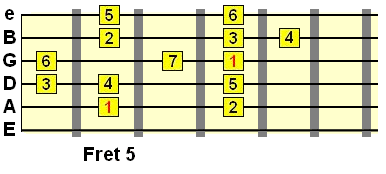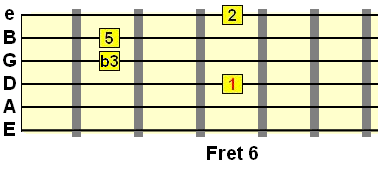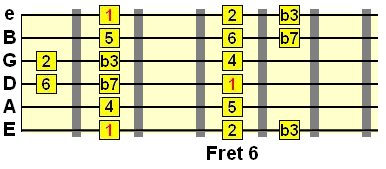Home
> Scales
/ Theory
> Chord
Scale Relationships
It's therefore important to know what tones the backing chords are using so you can highlight these same tones through your solo. There's an easy way to find a "starting point" for your solo in this respect, and that's what we'll be looking at in this lesson.
Video lesson
Here I take the concept in this lesson to its ultimate ends - to see the intrinsic relationship between chords and scales as a group of related intervals on the fretboard.
Let's say the piece begins on a D major chord, and you want to apply a major scale phrase over this chord.
The first thing to do is locate a potential shape for this D major chord. As there are several main shapes for this chord (based on those 5 barre/movable chord shapes) we should at this stage just pick one and run with it...
D major chord shape

This is one major chord shape you should know. It's the basic A form barre chord. Rooted at the 5th fret gives us D major.
Now, when learning scales, it's important to learn their boxed patterns on the low E string and A string root notes, for the very reason that it gives you a good starting point for playing over chord shapes like the above. I show you these patterns in the individual scale lessons.
D major scale pattern

We've simply superimposed the A string scale pattern we know right over the A form chord shape we know.
You only really need to identify the corresponding root notes, as this is the point from which both the chord shape and scale patterns are built.
However, we can also see a chord scale relationship between the 3rd and 5th tones used in both the major chord and the major scale. We could use these tones as "starting notes" if we wished.
So that's the basic idea. Identify a possible chord shape for the chord you're playing over and use a scale pattern in the same position. Again, it helps a great deal if you learn the main boxed patterns for each scale (that's why I include them in my guitar scale lessons!).
Now, I could give you a hundred and one examples of this same process with different chords and scales, but the concept is the same whichever chord-scale relationship you use.
For example:
A flat minor added 9th (Abmadd9) chord shape

So first we establish that the above is a minor chord. But there is also an added tone (the 2nd/9th) that we could (if we want) highlight in our solo. There is more than one minor scale that will work over this chord, but for this example I'm using Dorian...
A flat Dorian scale pattern

Again, notice how we can use our knowledge of the root note position of the chord shape and correspond it with a scale pattern that uses the same root note position. We now have a solid starting point for our A flat Dorian phrase/solo.
If in doubt, at first, start on the root note and work through the rest of the pattern from there. Eventually, you'll be able to identify other tones that reside in the scale pattern and start on those (e.g. the b3, 5, 2 etc.).
In a later lesson, we'll look at how this technique can help us solo over chord changes. For now, make sure you reference this lesson when learning individual scales. It really is a great way to find your bearings at first.
Learn Guitar Chords
Guitar Theory Lessons
Guitar Chord Scale Relationships
As you learn more and more scales, you'll notice certain chord-scale relationships emerge from the fretboard. Tones that are used in the backing chords need to correspond with the tones in the scale(s) you're playing, otherwise it'll clash.It's therefore important to know what tones the backing chords are using so you can highlight these same tones through your solo. There's an easy way to find a "starting point" for your solo in this respect, and that's what we'll be looking at in this lesson.
Video lesson
Here I take the concept in this lesson to its ultimate ends - to see the intrinsic relationship between chords and scales as a group of related intervals on the fretboard.
Identifying chord shape/scale pattern relationships
As a guitarist, you must be able to identify any chords you'll be playing with or over. This is an "ear skill" that will come with time, but I'm assuming that you'll at least be aware of the chord sequence you'll be playing over, whether you're improvising or writing a lead part for a song.Let's say the piece begins on a D major chord, and you want to apply a major scale phrase over this chord.
The first thing to do is locate a potential shape for this D major chord. As there are several main shapes for this chord (based on those 5 barre/movable chord shapes) we should at this stage just pick one and run with it...
D major chord shape

This is one major chord shape you should know. It's the basic A form barre chord. Rooted at the 5th fret gives us D major.
Now, when learning scales, it's important to learn their boxed patterns on the low E string and A string root notes, for the very reason that it gives you a good starting point for playing over chord shapes like the above. I show you these patterns in the individual scale lessons.
D major scale pattern

We've simply superimposed the A string scale pattern we know right over the A form chord shape we know.
You only really need to identify the corresponding root notes, as this is the point from which both the chord shape and scale patterns are built.
However, we can also see a chord scale relationship between the 3rd and 5th tones used in both the major chord and the major scale. We could use these tones as "starting notes" if we wished.
So that's the basic idea. Identify a possible chord shape for the chord you're playing over and use a scale pattern in the same position. Again, it helps a great deal if you learn the main boxed patterns for each scale (that's why I include them in my guitar scale lessons!).
Now, I could give you a hundred and one examples of this same process with different chords and scales, but the concept is the same whichever chord-scale relationship you use.
For example:
A flat minor added 9th (Abmadd9) chord shape

So first we establish that the above is a minor chord. But there is also an added tone (the 2nd/9th) that we could (if we want) highlight in our solo. There is more than one minor scale that will work over this chord, but for this example I'm using Dorian...
A flat Dorian scale pattern

Again, notice how we can use our knowledge of the root note position of the chord shape and correspond it with a scale pattern that uses the same root note position. We now have a solid starting point for our A flat Dorian phrase/solo.
If in doubt, at first, start on the root note and work through the rest of the pattern from there. Eventually, you'll be able to identify other tones that reside in the scale pattern and start on those (e.g. the b3, 5, 2 etc.).
In a later lesson, we'll look at how this technique can help us solo over chord changes. For now, make sure you reference this lesson when learning individual scales. It really is a great way to find your bearings at first.
| |
Tweet |
 Like This?
Subscribe & Learn More... Like This?
Subscribe & Learn More...Subscribe to the fretjam newsletter below for updates and extras, plus grab your free copy of Uncommon Chords: 101 Vibrant Voicings You Won't Find on a Typical Chord Chart. |
Related
Learn Guitar ScalesLearn Guitar Chords
Guitar Theory Lessons








